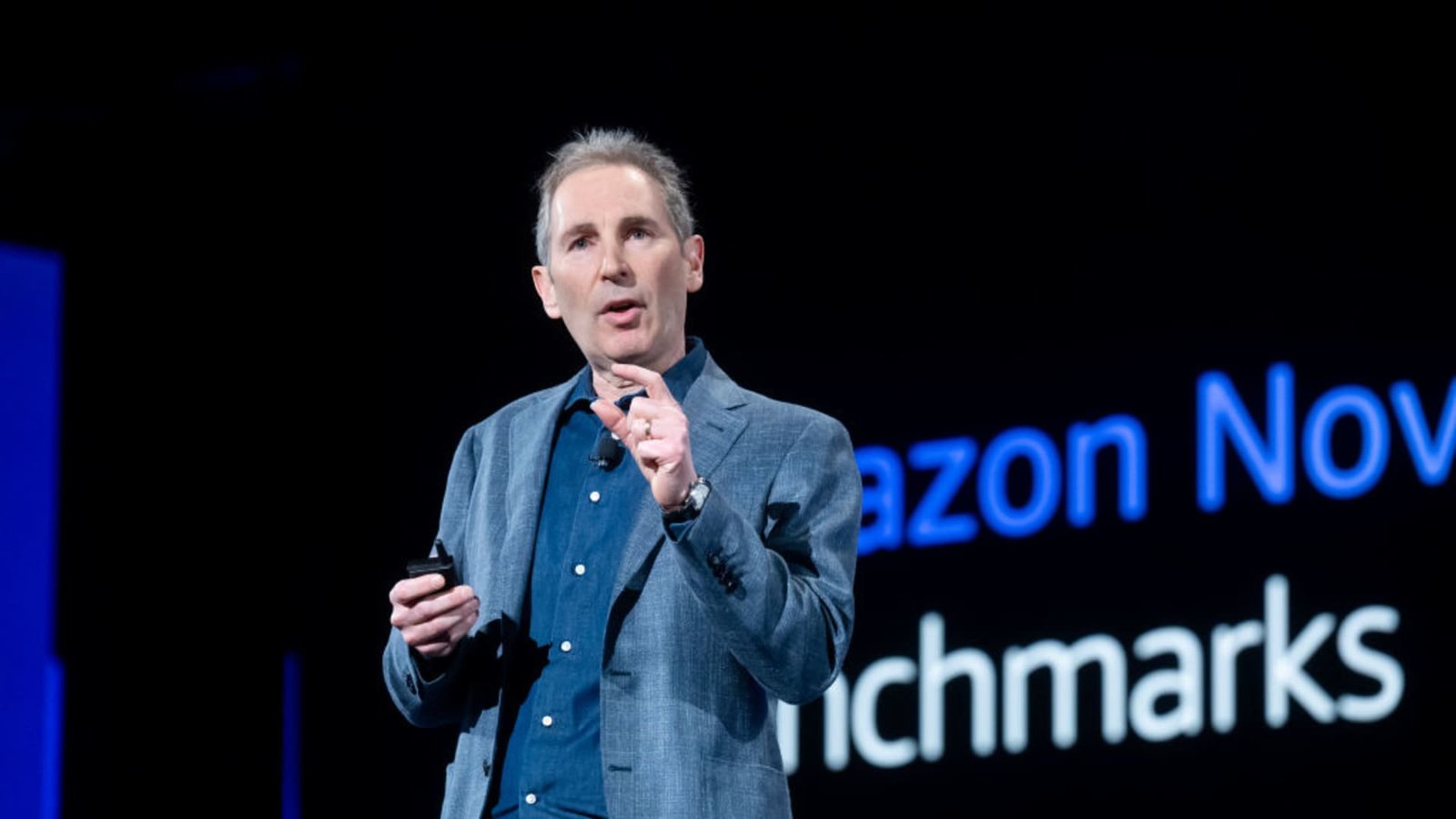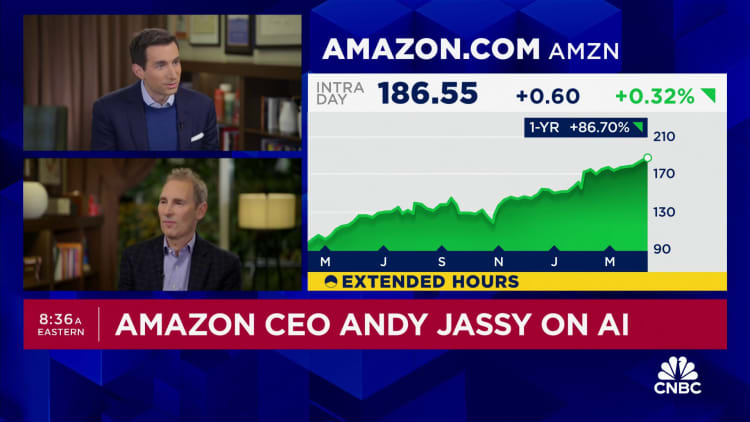Physical Address
304 North Cardinal St.
Dorchester Center, MA 02124
Physical Address
304 North Cardinal St.
Dorchester Center, MA 02124

Amazon CEO Andy Jassy speaks during a keynote at AWS re:Invent 2024, a conference hosted by Amazon Web Services, at The Venetian Las Vegas on December 3, 2024 in Las Vegas, Nevada.
Noah Berger | Getty Images Entertainment | Getty Images
Amazon CEO Note from Andy Jassy he drew headlines sent to employees about corporate culture this fall for his five-day term in office. But Jassy’s message about increasing the ratio of individual managers to assistants raises a much larger question about organizational structure: What is the right balance between individual employees and managers in the overall workforce? It’s a question that corporations have struggled to define with anything but anecdotal findings.
Businesses are now firmly in the post-Covid world, experts at the organization say Amazon may be the leader in a new look at the efficiency gains associated with corporate inflation, and especially middle management inflation.
“We’ve grown our teams quickly and significantly,” said an Amazon spokeswoman, echoing the message of Jassy’s statement: “When I think back to when I was at Amazon, I never imagined I’d be with the company for 27 years…I’ve stayed it’s been unprecedented growth (we were $15 million annually the year I joined, should be north of $600 million this year).
This growth, according to the spokesperson, inevitably led to the addition of many managers. Comparing Amazon’s plan The year of effectiveness of the metaThe spokesperson said the company added more layers than before due to its growth and now is the right time to bring the structure “closer to our customers” and strengthen Amazon’s “culture of ownership.”
In recent years, layoffs have been as prominent as hiring in the tech sector. In 2022-2023, the sector was in what could be called years of release. In the meantime cutting off the head he continues, Amazon’s thinking involves a broader rethinking of the extent of the rights of the largest corporations.
Analysts at Morgan Stanley suggested Amazon could cut it 14,000 management positionsas corporate efficiencies save $2 billion-$4 billion. Morgan Stanley’s announcement by Jassy in the note that Amazon aims to “increase the ratio of individual contributions to managers by at least 15%” by the end of 1Q25, across all divisions.
A person walks past The Spheres at the headquarters of Amazon.com Inc. on November 14, 2022 in Seattle, Washington.
David Ryder | Getty Images News | Getty Images
Jassy pointed to “artifacts” of increased headcount, such as “meetings before decision-making meetings,” and has created a “Bureaucracy Mailbox” for staff to share and make decisions that slow down decision-making processes. he said “we can go in and root”.
This is not a process unique to Amazon, said Joseph Roh, a professor at Texas Christian University’s Neeley School of Business. Rapid growth can lead to adding “layers of management” without re-evaluating whether those roles are necessary. In general, there is a flatter structure, and more emphasis is now placed on the individual contributions of corporations. There is no set formula, no “golden ratio” for assistant managers. “My understanding is that the ideal ratio of individual contributors to managers depends largely on the nature of the work,” Roh said, but added that generally it’s about 7 to 10 people per manager.
Investor and economic pressures play a role, and at a time when tech giants are spending billions on AI without giving Wall Street immediate evidence of a return on investment, a conscious effort to cut other costs will be rewarded. And while companies like Amazon want everyone back in the office to bounce ideas around the proverbial whiteboard or the water cooler, it seems that AI is already acting in a more direct way, with some. redundant middle management positions.
“Digital transformation plays an important role,” said Roh, “as automation and advanced technology reduce the need for middle managers to oversee tasks that can now be controlled through software.”
“What you’ve seen from Amazon is just the beginning,” said Naeem Zafar, a professor at UC Berkeley’s Haas School of Business and Northeastern University, pointing to a larger trend of downsizing the management layer that will spread throughout corporate America. Technology companies that have dominated the economy and grown rapidly are leading the way, preaching a return to an approach of being agile and innovative, but Zafar said there are also cultural factors at work. “The new generation of workers is different and they work differently,” he said, citing the increasing use of communication tools and an overall work culture ethos that privileges freedom and rejects micromanagement.
According to Roh, organizations are adapting to the preferences of a younger workforce that “values less hierarchy and more autonomy in their roles.”
Zafar said the rise of AI along with a new generation of workers reinforces this evolutionary approach for managers. “Amazon’s shrinking of manager roles isn’t just about cutting costs; it’s a look at the future of work. Tech is eating away at the traditional corporate ladder, and middle management is feeling the bite,” Zafar said.
For decades, managers have been considered the “glue of interconnected companies” and the key to turning strategy into action. But today, Zafar said, “AI-powered tools can analyze data, assign tasks and track performance with unprecedented efficiency.” This inevitably leads to the question, “Why pay a middleman when a machine can do it better?” he added.
Roh said Amazon’s growth may be an extreme example, but it’s also perhaps a leading indicator. “Amazon’s realignment reflects a broader corporate trend toward leaner and more efficient organizational structures, driven by the need to control costs, innovate and compete in rapidly evolving markets,” he said.
From healthcare to finance, companies are realizing that flatter hierarchies mean faster decisions and potentially higher profits. Just as efforts are made to improve efficiency and the bottom line, there are risks in the era of company alignment. Employee well-being and sacrificing the essential human elements of leadership and innovation are challenges that will be at the center of this reshaping of corporate America, Zafar said. But he added: “The future belongs to companies that can build lean, lightweight structures, empowering workers to thrive in a world where machines make heavy.”
